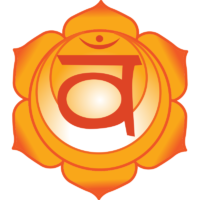In our previous blog post, we discussed the chakra system. You can take a gander at that by clicking here.
We then elaborated on the first chakra – muladhara, also known as the root chakra. From there, the chakras are as follows:
- Root Chakra (Muladhara)
- Sacral Chakra (Swadhisthana)
- Solar Plexus Chakra (Manipura)
- Heart Chakra (Anahata)
- Throat Chakra (Vishuddha)
- Third-Eye Chakra (Ajna)
- Crown Chakra (Sahasrara)
In this post, we’ll move up svadhishthana chakra to get a deeper understanding of what the sacral chakra represents.

Svadhishthana Chakra, A.K.A. the Sacral Chakra
Svadhishthana comes from the Sanskrit for sva (self) and shthana (place). It is located above the pubic bone and below the navel and it encompasses the genitals.
The sacral chakra marks the second level of our development as we evolve toward human consciousness. It’s the seat of the subconscious mind and it’s the place where every life experience and impression since your conception are stored.
It is also marked by creativity.

Creativity can be expressed as procreation, but also any other activity in which we are using creativity. Essentially, any time we take physical or mental raw materials and transform them into something new, we are engaged in creativity.
As such, those who are driven primarily by the sacral chakra have vivid and active imaginations. They’re also able to verbalize their perceptions, which makes them shine in professions that involve guiding or healing.
What the Sacral Chakra Represents
Svadhisthana relates to the lower part of the trunk, pelvic area, the buttocks and genitals. It is also associated with the kidneys, appendix, prostate, gonads, the lymphatic system, and all the body fluids.
When svadhishthana is open, you feel free in expressing yourself both sexually and creatively. There is the ability to respect the body and to be playful and experience pleasure in a healthy way.
In addition, money flows freely to and from you, and you’re able to remain flexible in changing situations. You don’t cling to things or ideas and are able to explore your boundaries without feeling guilty or losing yourself. You have a strong sense of self and know your worth.
The positive qualities of the sacral chakra include joy, faith, self-confidence, and energy. The negative attributes, however, are anger, hatred, jealousy, cruelty, desire, and pride.

Because of its relation to bodily fluids, svadhisthana is represented by water. And while water can be soft, gentle, and pliable, it also possesses immense power when out of control. And this is what can happen when the sacral chakra is knocked out of balance.
Imbalances in the Sacral Chakra
When svadishthana is over-active, it can result in sexual or pleasure addictions, excessive sensitivity, and strong emotional dependency. Such addictions may cause one to be seductive and manipulative – taking advantage of others.
On the flip side, in cases where the sacral chakra is under-active a person may have poor social skills, a fear of sex, a denial of pleasure, and/or a lack of passion.
Physical imbalances can manifest as lower back pain, urinary tract infections, ovarian cysts and other reproductive health issues, complications with the bladder and kidneys, and sexual dysfunction from impotence to low libido.
Bringing the Sacral Chakra Back into Balance
Left nostril breathing called Ida Nadi breathing can help open up your second chakra. Close off your right nostril with the first two fingers of your right hand. Then inhale and exhale exclusively through the left nostril for 8 to 10 breaths.
There are also specific yoga postures that focus on a grouping of nerves low on the back known as the sacral plexus. Among them are camel, cobra, eagle, cat, and locust.

Engaging both mula bandha and uddiyana bandha (energy locks) while practicing yoga will also help maintain energy in this chakra. For mula bandha, simply engage the muscles one uses to restrict the flow of urine and keep them engaged. For uddiyana bandha, locate the place three fingers width under your belly button, then gently pull in and up to engage.
Meditation is also beneficial. Chanting or toning sounds during meditation can create vibrations in the body, and these vibrations help the cells work together in harmony. The mantra sound that corresponds to the sacral chakra is VAM (pronounced “vahm”).
Finally, many believe that the energy from certain gemstones can help bring chakras back into balance when placed on the area of the chakra. The best gemstones for the sacral chakra are orange and they include amber, calcite orange, carnelian, or hematite.
Could You Benefit from Balancing Your Chakras?
The simple answer is yes. And in the coming weeks on this blog, we’ll continue to move up the sushumna nadi to explore the other chakras, what they represent, and how to bring them into balance.
These practices take time, patience, willingness, and guidance though. This is precisely why we’ve developed specific yoga/mindfulness/meditation programs and life coaching sessions that cater to your individual or your company’s, school’s, or organization’s needs.
Contact us today to find out how we can bring these practices to you – either in person or virtually. And find balance once again.



